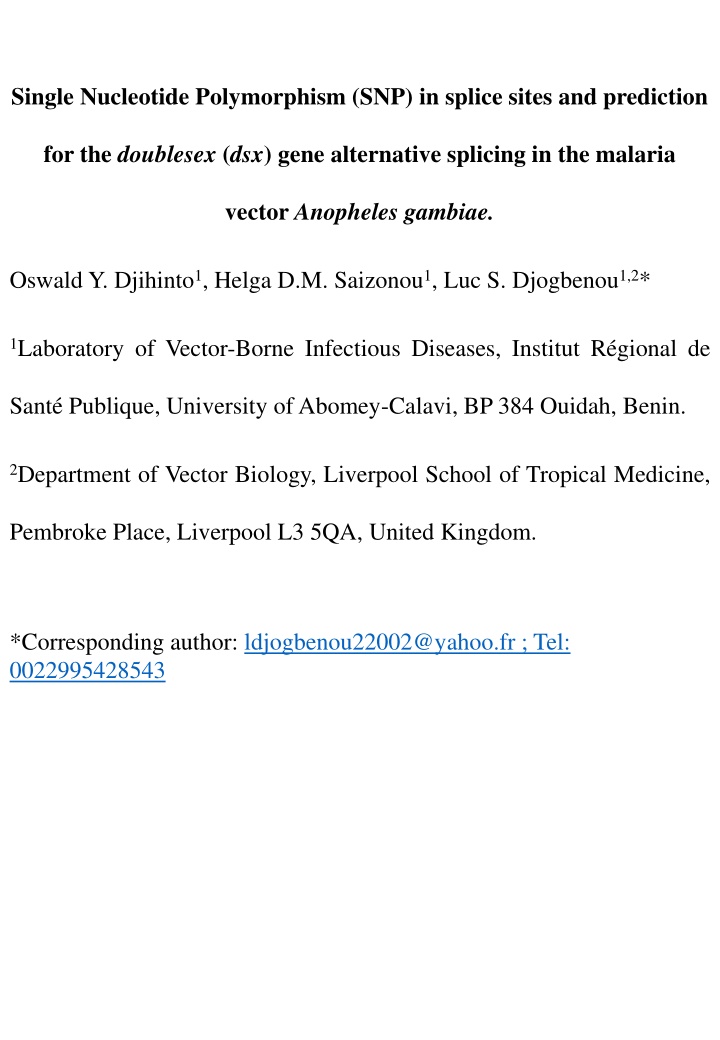
SNP in Splice Sites and Prediction for dsx Gene Alternative Splicing in Anopheles gambiae
Explore single nucleotide polymorphisms (SNPs) in splice sites of the doublesex (dsx) gene, impacting alternative splicing in Anopheles gambiae, the malaria vector. The study focuses on SNPs within exon and intron splice sites, offering insights into male and female mosquito genetic variations.
Download Presentation

Please find below an Image/Link to download the presentation.
The content on the website is provided AS IS for your information and personal use only. It may not be sold, licensed, or shared on other websites without obtaining consent from the author. If you encounter any issues during the download, it is possible that the publisher has removed the file from their server.
You are allowed to download the files provided on this website for personal or commercial use, subject to the condition that they are used lawfully. All files are the property of their respective owners.
The content on the website is provided AS IS for your information and personal use only. It may not be sold, licensed, or shared on other websites without obtaining consent from the author.
E N D
Presentation Transcript
Single Nucleotide Polymorphism (SNP) in splice sites and prediction for the doublesex (dsx) gene alternative splicing in the malaria vector Anopheles gambiae. Oswald Y. Djihinto1, Helga D.M. Saizonou1, Luc S. Djogbenou1,2* 1Laboratory of Vector-Borne Infectious Diseases, Institut R gional de Sant Publique, University of Abomey-Calavi, BP 384 Ouidah, Benin. 2Department of Vector Biology, Liverpool School of Tropical Medicine, Pembroke Place, Liverpool L3 5QA, United Kingdom. *Corresponding author: ldjogbenou22002@yahoo.fr ; Tel: 0022995428543
A B Figure 1: Single Nucleotide Polymorphism within exon 2 and intron 2 splice sites. A) SNPs within exon 2 donor splice site between An. gambiae male and female mosquitoes. Legend is similar to Figure 3. The uppercase and lowercase letters denote respectively coding and non-coding region. B) SNPs within intron 2 acceptor splice site between An. gambiae male and female mosquitoes. See Figure 4 for legend. The uppercase and lowercase letters denote respectively coding and non-coding region.
A B Figure 2: Single Nucleotide Polymorphism within exon 3 and exon 4 splice sites. A) SNPs within exon 3 donor splice site between An. gambiae male and female mosquitoes. See Figure 4 for legend. The uppercase and lowercase letters denote respectively coding and non- coding region. B) SNPs within exon 4 donor splice site between An. gambiae male and female mosquitoes. See Figure 3 for legend. The uppercase and lowercase letters denote respectively coding and non-coding region.
A B Figure 3: Single nucleotide polymorphism in the last Agdsx acceptor and donor splice sites. A) SNPs within the common acceptor site (Intron 4/5) between An. gambiae male and female mosquitoes. The female ( ) specific exon 5 is included in the male ( ) intron 4 sequence making a shift in exon number is male. Thus, the male intron 4 and female intron 5 share the same 3 end. Similarly, the male exon 5 and female exon 6 share the same 5 end region. B) SNPs within the common donor site (Exon 5/6) between An. gambiae male and female mosquitoes. The female ( ) specific exon 5 is included in the male ( ) intron 4 sequence making a shift in exon number is male. Thus, the male exon 5 and female exon 6 share the same 3 end. Similarly, the male intron 5 and female intron 6 share the same 5 end region.
